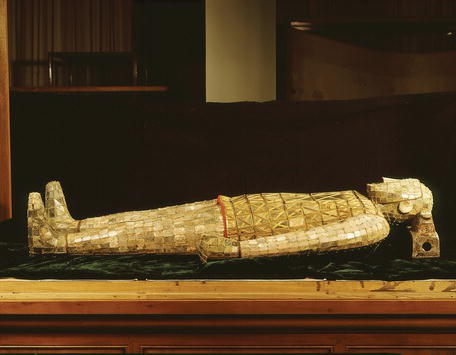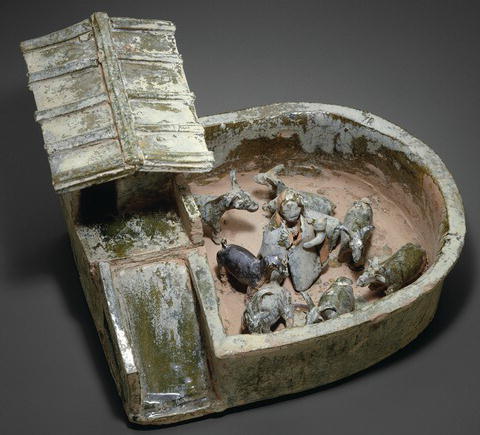A History of China (23 page)
Read A History of China Online
Authors: Morris Rossabi

Figure 3.5
Funeral suit of Princess Tou Wan, wife of prince Liu Sheng, jade, Western Han dynasty, late second century
BCE
, from her tomb at Mancheng, Hebei province, China, 172 cm, seen from side. © The Art Archive / Alamy

Figure 3.6
Han-dynasty animal pen. New York, Metropolitan Museum of Art, Charlotte C. and John C. Weber Collection, Gift of Charlotte C. and John C. Weber, 1994. Inv. no. 1994.605.21. © 2013. Image copyright The Metropolitan Museum of Art / Art Resource / Scala, Florence

Artistic developments also often reflected the grandeur of Han aspirations. Elaborate tombs with numerous burial objects confirm the desire for majesty and ornateness. The varieties of shapes (rectangular, square), materials (stone, brick), and motifs (bedrooms and a kitchen for the comfort of the deceased in the afterlife) reflect the differing regions in which the tombs have been uncovered. The tombs of Liu Sheng (d. 113
BCE
; Emperor Wu’s elder brother) and his wife, Dou Wan, which were discovered in 1968, offer evidence of attempts to show off the court’s majesty. The corpses were clothed in suits composed of about two thousand pieces of jade, linked with gold thread. This elaborate, costly, and painstaking work, which was designed to preserve the bodies but also meant to show the dynasty’s majesty, indicates the grandiose ambitions of the Han elite. Both life-size and miniature sculptures reveal similar objectives: the desire for grandiosity and the intricacy of exquisite detail. Large statues in front of the tombs honored Han generals and officials, and relatively small clay figurines of servants, animals, and entertainers were buried with the deceased. Because members of the elite planned to recreate their lavish lifestyle in the afterlife, they required the services of these clay representations of men and animals who had served them during their sojourn on Earth. The era of sacrifices, particularly human victims, had passed long ago. The Han elite thus substituted models (
mingqi
), which included watchtowers, musicians, acrobats, and domestic animals, to accompany the corpses on their presumed journeys after death. These exquisitely detailed figurines and objects, which required vast amounts of labor, confirm the grandness of the elite’s vision of themselves and their society. Like the tombs of earlier dynasties, Han graves contained numerous bronze artifacts, including harnesses, swords, drums, belt buckles, and mirrors, which were often embellished with elaborate decorations of real and mythical animals, humans, and symbols representing the prevalent
yin-yang
and Five Phases cosmogony. Jade objects (e.g. the burial suits for Liu Sheng and Dou Wan), and lacquer bowls, baskets, and boxes, with depictions of humans, animals, and landscapes, also testify to the Han’s majestic and ostentatious aspirations.
Han art, in addition, attests to China’s increasing contacts with the outside world. Chinese silks, which were transported via the numerous silk roads that led to the west, were highly valued. To the south, the silks reached India, but the Indian practice of cremation of the dead in full dress, as well as the hot and humid climate, meant that few such textiles survived in the neighboring subcontinent. India also exported Chinese textiles to the Roman Empire, another reason few remain in India. A further outlet for the textiles was the Xiongnu elite, whose demand for Chinese silks was met by the development of a new silk road that wound its way to Mongolia. Chinese silk panels and fabrics have been uncovered at the tombs of Xiongnu leaders at Noyan Ula, an indication of the value accorded them by the nomadic rulers. Designs with animals, as well as cloud motifs, appealed to the nomadic pastoral elite. Such designs apparently attracted the peoples of central Asia, west Asia, and the Roman Empire.
Silk Roads caravans wound their way from various centers in China to its northwestern frontiers, where they encountered the inhospitable Taklamakan Desert, which they skirted via such northern towns and oases as Turfan and Hami or via the south through such towns as Khotan. They then intersected at Kashgar and headed west through Persia to west Asia. A number of silks and silk fragments have been found at Turfan and other Silk Roads oases; some were clearly designed for an export market. As will be apparent later, China’s growing contacts with the outside world influenced its culture, challenging the view that China was self-sufficient and isolated.
Painting, the other great art form identified with the Chinese, has left barely a trace in this era. Wall paintings enlivened many Han palaces and homes, but these have not survived. Paintings on silk generally met the same fate. Paper had been developed, but painters scarcely understood the possibilities of this new medium. Some paintings in tombs have survived. They range from depictions of daily life (including farming, hunting, and fishing tableaux) to representations of human figures and divinities illustrating Confucian morality and Daoist ideals. It seems likely that the paintings that have not survived dealt with similar motifs – human figures symbolizing Confucian tenets described and analyzed in the Five Classics, clouds and other natural scenes, and palaces, houses, and other buildings. Depictions on lacquerware, the finest examples of which were produced in Sichuan, focus on the same subjects: animals and natural scenes and humans representing Confucian or Daoist precepts. Like silk, lacquer appears to have been highly prized abroad because boxes and other lacquer vessels have been found in a wide area, ranging from Korea to central Asia. The names of two painters have been found inscribed on lacquer objects unearthed in Lelang, Korea; by a remarkable coincidence, these same names were also found on a lacquer artifact unearthed in Noyan Ula.
A variety of foreign discoveries filtered into Han China. Glass and pearls reached China by sea via the Indian Ocean; alfalfa, a feed for horses, and grapes were central Asian and Persian contributions that Zhang Qian probably introduced; and oranges and lichee nuts became familiar as the Han colonized south China. Pomegranates, walnuts, and other products from Persia and central Asia that were attributed to Zhang Qian’s mission actually arrived later, when China had even more extended contacts with the outside world. Cultural imports were as significant. The Chinese lute, known as the
pipa
, had central Asian ancestry, and its prototype is reflected on earlier sculptures found in central Asia. In the south, the Chinese were exposed to the zither.
In addition to music, other entertainments owed much to foreign influence. Persian and central Asian jugglers and acrobats brought their skills to the court. A few foreign dancers may have reached Han China, but the real vogue for foreign dancing developed in later dynasties. Falconry, a practice associated with the pastoral peoples on the northern frontier, also began to reach the sedentary agricultural Chinese.
Figure 3.7
Female dancer, Western Han dynasty (206
BCE
–9
CE
), second century
BCE
, earthenware with slip and pigments, H. 21″ (53.3 cm). New York, Metropolitan Museum of Art, Charlotte C. and John C. Weber Collection, Gift of Charlotte C. and John C. Weber, 1992. Acc.no.: 1992.165.19. Photo: Seth Joel. © 2013. Image copyright The Metropolitan Museum of Art / Art Resource / Scala, Florence

This vibrant culture also manifested itself in technical and scientific discoveries. Paper was invented in the Later Han, but at that time the Chinese scarcely made use of it. They were more aware of and made use of bricks, another discovery, in tomb construction. As was to be expected of an agricultural society so concerned with Heaven and with possible natural threats to its livelihood, astronomy made great strides. Han astronomers discovered sunspots, calculated with precision the number of days in a year, and ascertained the moon’s exact orbit. Zhang Heng’s invention of a seismograph – evidence of the pragmatic nature of China’s scientific efforts and of its focus on natural disasters – has already been mentioned. Pragmatism and a scientific attitude were also evident in the writings of Zhang Heng and Wang Chong, who both emphasized a critical attitude as a guideline for inquiry about and analysis of natural phenomena.
In sum, despite its failures and eventual collapse, the Han played a central role in the development of Chinese civilization. It created the first effective governmental institutions to rule the entire country and adopted Confucianism as the state cult. Confucianism defined proper relationships between the generations and designated gender roles, and Ban Zhao, the foremost woman scholar of ancient China, described proper behavior for women. The Han delineated a new system of foreign relations, and, by creating ritualized, economic, and political methods of dealing with foreigners, it simultaneously affirmed the identities of those within its borders as different from the outsiders. It established institutions for local government and performed vital societal tasks, including conducting a census – perhaps the first such undertaking in world history. The census registered a total of over fifty-five million people, making China the world’s most populous country. The greater population was mostly in the rural areas, but the capital city and a few other cities attested to the first significant urbanization in Chinese history. Economic growth and greater agricultural production in the countryside permitted the development of such urban centers.
URTHER
R
EADING
Bret Hinsch,
Women in Early Imperial China
(Lanham, MD.: Rowman & Littlefield, 2002).
Mark Lewis,
Early Chinese Empires: Qin and Han History
(Cambridge, MA: Harvard University Press, 2007).
Michael Loewe,
Everyday Life in Early Imperial China During the Han Period,
202
B.C.–A.D.
220
(New York: Putnam, 1968).
Yu Ying-shih,
Trade and Expansion in Han China
(Berkeley: University of California Press, 1967).
C
HAOS AND
R
ELIGIOUS AND
P
OLITICAL
R
ESPONSES,
220–581
HREE
K
INGDOMS
The immediate aftermath of the Han’s collapse saw the fragmentation of China into the Three Kingdoms (
Sanguo
). In 220, Cao Pi (187–226) overthrew the Later Han and established his own Wei dynasty in China’s traditional heartland. He gambled that his control over Luoyang and Changan, the two preeminent capital cities, would offer him legitimacy and would quell political challenges to his rule. His gamble did not pay off, for shortly thereafter Liu Bei (161–223), a descendant of the Han imperial family, created his own dynasty in Sichuan, Guizhou, and Hunan. Chinese later dubbed Liu’s dynasty the Shu Han, the Shu deriving from the name of the state in Sichuan during the Zhou dynasty. In 222, a certain Sun Chuan (182–252) also broke away, founding the Wu dynasty in the region to the south, adjacent to the Yangzi River. The Three Kingdoms clashed repeatedly as each jockeyed for position and sought to dominate as the principal unifier of China.